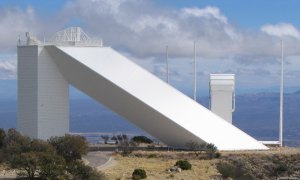India Launches its Biggest Telescope MAST in Udaipur
In a groundbreaking achievement, India uncovered the biggest telescope of the nation namely “Multi Application Solar Telescope” (MAST) at the Udaipur Solar Observatory on Tuesday.
Udaipur Solar Observatory (USO) belongs to the group of six sites around the world known as the Global Oscillations Network Group (GONG).
MAST was put into action in order for USO to carry out a detailed analysis of solar happenings that could enable predicting weather conditions of space in the future.
MAST will help scientists to research on other planets and their movements, utilizing multiple line diagnostics as well as obtaining a 3D picture of the occurrences.
UR Rao who is the chairman of the governing council of the Physical Research Laboratory, Ahmedabad launched the telescope, explaining that MAST would facilitate the learning of stars and sun even in daylight.
The project was sponsored by Physical Research Laboratory (PRL), which is an independent entity of the Department of Space and sanctioned by the Ministry of Science and Technology, and until now Rs. 26 crore has been funded on MAST.
According to a statement, MAST is different from other telescopes in that it is able to grasp 3D sides of the “solar magnetic fields” additionally helping the scientists to have an even better learning of the solar bursts and explosions occurring in those magnetic fields.
Professor Venkatakrishnan who head the research team in the MAST project said informed that they plot to offer a longstanding figures to continue to getting MAST’s services on unresolved solar cycle associated issues like magnetic stress behaviors as an outcome “of the epoch of the solar cycle.”
Media reports have said that Udaipur Solar Observatory was chosen for launching MAST because it is engulfed by water that helps in keeping the temperature nice, and the site provides over 250 days of constant sunshine, which permits observation of sun properly at the day time as well.
In fact, India’s telescope venture comes close on the heels of what China announced last week that it was building the world’ largest radio telescope in the Guizhou province. The construction for the 500-meter “Aperture Spherical Telescope” (FAST) commenced in March 2011, to be finished by September 2016.
The vast telescope will cost nearly 12 billion Yuan (120 million Euros),and Li Di, who is the lead scientist of the National Astronomical Observatories Chinese Academy of Sciences, said that FAST will rule the world as the best telescope for the coming 20 to 30 years, following its completion.
Otherwise, both India and China as reported in our earlier article are members of the Five-Club that is building Japan’s ambitious next-generation “Thirty Meter Telescope” (TMT) which may cost Rs.14,300 crore ($1.47 billion). Other countries in it are Canada, US, and Japan. Believed to be completed by 2020, TMT will possess the highest altitude till date, and will be the second-largest telescope in the world after E-ELT.
